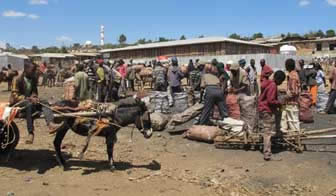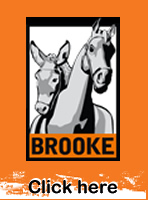
Horseytalk.net Special Interview
Verity Owers
Hope at Hosaina
Before the Brooke started working in the area six years ago, donkeys would arrive exhausted and laden with grain having travelled with their owners for several hours.
The Brooke funded the building of a shelter to provide a much needed refuge for the animals. Now they have somewhere clean and cool to enjoy food, rest and water where their owners know they will be safe and well-cared for.
Says Verity Owers, Legacy Relationship Officer, The Brook
 Throughout our trip to Ethiopia we loved sampling the rich, spicy flavours of the local cuisine - a vegetable or meat stew (wat) served on top of a large pancake called injera.
Throughout our trip to Ethiopia we loved sampling the rich, spicy flavours of the local cuisine - a vegetable or meat stew (wat) served on top of a large pancake called injera.
Everyone shares from the same large dish, using their hands to break off pieces of the injera to scoop up tasty mouthfuls of wat, making mealtimes a very sociable occasion.
Essential to these meals is tef- the grain used to make the injera. With similarities to millet or quinoa, tef is the smallest grain in the world. So small in fact, you would need about 150 grains of tef to get the same weight as just one grain of wheat!
Despite this it’s an important source of nutrition containing calcium, iron and potassium among many other vitamins and minerals. It’s versatile too and can
Despite this it’s an important source of nutrition containing calcium, iron and potassium among many other vitamins and minerals. It’s versatile too and can be prepared in a number of ways.
Driving from Addis Ababa we saw tef growing in plots beside family homes as well as in fields alongside the road. Every year Ethiopian farmers plant about 1.4million hectares from which they produce around 0.9 million tons of grain. Tef is therefore essential to feeding a large part of the population.
Just as tef itself is essential, so too are the donkeys, horses and mules that play a vital yet often hidden role in ensuring this food supply. As well as working long hard days to bring in the crop, they carry huge loads of hay and travel from miles around to bring the sacks of grain to be sold at the market in Hosaina.
In one area of the market, women buy small quantities of tef for household use. In another the grain is sold in large sacks. Sellers show off a handful of grains in the palm of their hand to potential buyers to prove their grain is of the best quality. Elsewhere, a miller showed us the machinery he uses to mill the grain into flour his face covered in fine white powder from the dust produced in the process.
Before the Brooke started working in the area six years ago, donkeys would arrive exhausted and laden with grain having travelled with their owners for several hours. Many would have to stay standing for hours in the blazing hot sun until their owners had sold enough produce to be able to return home.
Owners were reluctant to unload their animals for fear that either the grain or donkey would be stolen. Responding to that need, the Brooke funded the building of a shelter to provide a much needed refuge for the animals. Now they have somewhere clean and cool to enjoy food, rest and water where their owners know they will be safe and well-cared for.
Around the market, owners not using the shelter feed their donkeys and horses on a mix of tef and bran – a vast improvement from the rubbish they were left to forage on before the Brooke raised awareness of the need to provide more and better feed. In this way, the hidden role of these hard working animals in helping to ensure the supply of tef as an essential food stuff for humans is now being recognised and respected.



